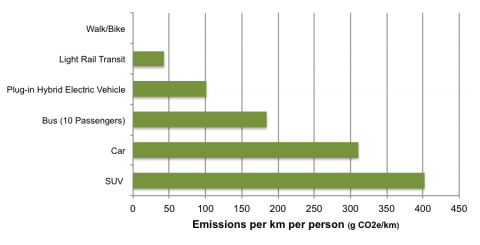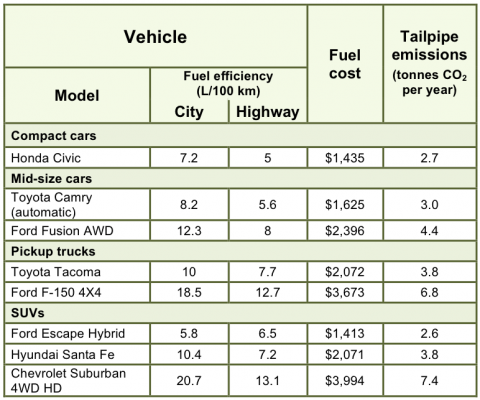Just minutes into the second U.S. presidential debate, the focus turned to gas prices and the role the government should or could play in keeping the price of fuel low. President Obama promised he would increase all forms of American energy production to “make sure that you’re not paying as much for gas.”
Gas prices are also on the minds of drivers this side of the border, with popular websites such as Tomorrow’s Gas Prices Today catering to Canadians searching for the cheapest gas in town.
Cost isn’t the only issue to obsess over when getting behind the wheel. The average Canadian driver emits about 4.6 tonnes of greenhouse gas pollution per vehicle — or more, if we include upstream emissions from extracting oil, refining it and transporting the fuel to the gas pump.
Remember the BP Deepwater Horizon oil spill in the Gulf of Mexico? Collectively, Canadian drivers consume roughly 50 times the amount of oil that spilled during that disaster — about 243 million barrels of oil — each year. Consuming that much oil contributes to the impacts of oil extraction and production in Canada and elsewhere, from Alberta’s oilsands to offshore drilling.
But every Canadian driver, from the urban dweller to the country roadster can make huge reductions in the amount of fuel they burn and the emissions they produce. Behind the Wheel — the latest report on sustainable transportation from the Pembina Institute — quantifies the individual and collective benefits from various choices Canadian drivers can make to reduce the amount of time spent behind the wheel, save money and reduce their environmental impact.
Figure 1: Emissions per kilometre by transportation mode

Note: Calculated using data from Transport Canada's Urban Transportation Emissions Calculator.
Leave the car at home
The graph above shows the relative impacts of how Canadians get around. The largest pollution reduction and money savings can be made by leaving the car at home: taking transit a few times a week saves hundreds of dollars and reduces greenhouse gas emissions by more than 10 per cent. Ditching the car altogether in favour of more active transit (such as riding a bike or walking) would result in over $10,000 in savings and up to 100 per cent less greenhouse gas pollution than commuting by car.
But not every Canadian lives in the city core and has this option.
For the suburban driver where transit is a long, slow bus ride with lots of transfers, a growing option is to carpool, which can lead to significant savings for the environment and the wallet — as Table 1 (below) demonstrates.
Table 1: Potential annual savings from a carpooling program

Choose a cleaner vehicle
Options like carpooling, transit or biking are not available to everyone. Many Canadians live in more dispersed locations or have travel patterns where transit is impractical and driving is required. Behind the Wheel examined the cost and pollution savings from simply choosing a cleaner vehicle. Zero-emission electric vehicles are a clean choice for the environment but require a cost investment up front — even though the fuel cost savings pay off over time.
Alternatively, just switching from a big guzzler like an SUV to a smaller vehicle can save hundreds of dollars a year in fuel costs, resulting in one less trip to the gas station every month, and an additional savings of about $10,000 off the sticker price. Still, some Canadians require a pick up truck for their job — in which case choosing a more efficient vehicle in the same class is a good option and can still save a trip to the gas station per month.
Table 2: Comparison of vehicle fuel efficiency and tailpipe emissions

Drive more efficiently
Regardless of the vehicle, practicing techniques behind the wheel to drive smarter and more efficiently — such as driving smoothly, getting your vehicle serviced regularly, avoiding idling, taking tire pressure and reducing speed — can cut greenhouse gas emissions and costs by up to 20 per cent
Collective mobilization
As individuals, we can make significant differences to our pocketbooks as well as to our lifestyle like getting more exercise and spending less personal time in traffic jams. For example:
- If you live in the downtown core, you can save $10,000 per year and reduce personal pollution by over 80% by ditching the car in favour of taking transit to work.
- If you live in the city suburbs you can save over $1000 per year and reduce pollution by 36% by switching from a mid size to a compact car, carpooling two to three times a week and practicing more efficient driving techniques.
- If you live in a rural region you can save over $1200 and reduce pollution by almost 40% by choosing a more efficient model of pickup and driving more efficiently.
- If you commute significant distances from the suburbs you can save over $4000 and reduce pollution by about 75% by telecommuting twice a week, moving closer to work, trading in the SUV or pickup for a mid-size car and practicing smarter driving.
Collectively as a nation, we can make an even bigger difference. If half of all Canadians drivers were to take one or two of these simple and cost effective actions, we could reduce greenhouse gas pollution by about 16 million tonnes — that’s equivalent to taking 20 per cent of Canada’s cars off the road.
And at the end of the day, it means we’d be spending less time in traffic — and less time checking websites for gas prices.








